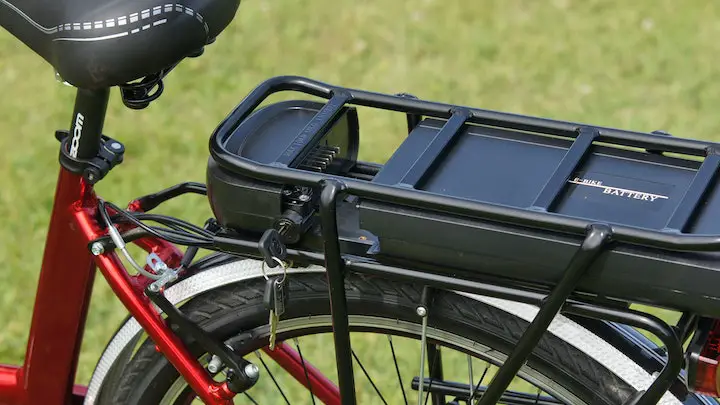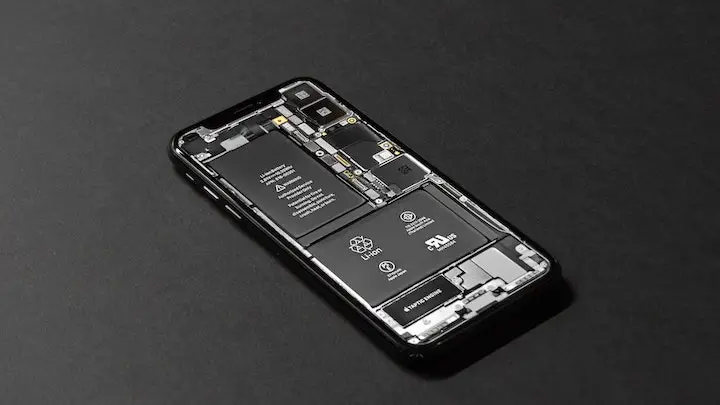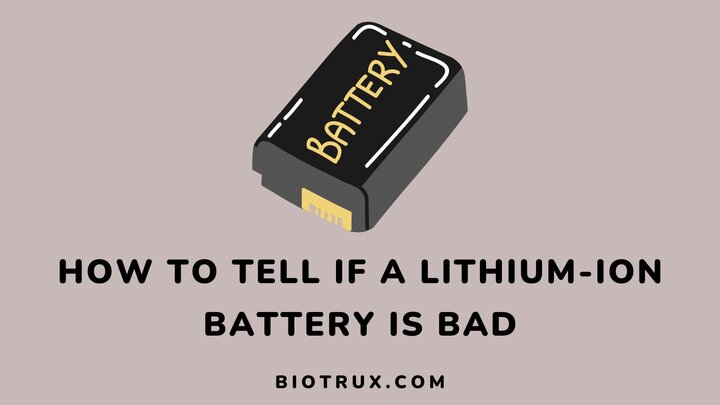Lithium-ion batteries are electrochemical systems commonly found in smartphones, laptops, and other gadgets with power-storage ability. With their increased popularity, knowing how to tell if a lithium-ion battery is bad or failing is essential.
Ideally, you should not expect your lithium-ion battery to last forever. While they feature a Battery Management System (BMS), it only makes them safer and more reliable.
If your lithium-ion battery is bad, signs to watch out for include a reduction in battery capacity, a high self-discharge rate, and overheating.
While this guide is about these warning signs and their severity, extra maintenance tips and how to repair lithium-ion batteries will also be included.
Types of Lithium-Ion Batteries

There are 6 significant types of lithium-ion batteries. Each of these batteries offers different cycle life or longevity. A prior understanding of this will help you tell if a lithium-ion battery is bad or not:
- Lithium cobalt oxide: features in cell phones and computers and can last 2 to 3 years.
- Lithium manganese oxide: features in medical equipment and lasts 10 to 20 years.
- Lithium iron phosphate (LFP): is used in electric bikes and can last for more than 12 years.
- Lithium nickel manganese cobalt oxide (NMC) – features mainly in electric vehicles and can last up to 10 years or more.
- Lithium nickel cobalt aluminum oxide – also features in electric vehicles and can last for 5 years or more.
- Lithium titanate – features in electric buses, solar energy, and military applications. This battery can last up to 30 years or more.
Factors That Can Damage Your Lithium-Ion Battery
Despite being strong and protected by the BMS, several internal and external factors can damage your lithium-ion battery:
- Internal Factors – overcharging, using inferior components during assembling, and other manufacturing errors.
- External (environmental) factors – heat, cold, water, air, and physical damage or shock.
How to Tell If a Lithium-Ion Battery is Bad
You can tell if your lithium-ion battery is bad or not in different ways. Some of these warning signs can be alarming, while others may indicate natural degradation over time.
Low-level warning signs
These signs are rarely visible and usually do not pose any threat to human and environmental safety. They include:
- Reduced battery capacity
- Low voltage
- High rate of self-discharge
High-level warning signs
These signs primarily relate to your battery’s physical condition and threaten human and environmental safety. They include:
- Swollen battery
- Overheating
- Weird smell
- Battery discoloration
If you detect any high-level warning sign, ensure you disconnect the battery immediately and store it in a ventilated area or take it to a battery station.
Can You Repair a Damaged Lithium-Ion Battery?
Repairing a damaged or bad lithium-ion battery is possible. However, it depends on the condition or type of warning sign(s) you detect.
If you detect a high-level or alarming sign, such a battery cannot be repaired. The ideal thing is to take it to a battery station. They will help you transport it to a recycling facility.
In cases where a lithium-ion battery displays only low-level warning signals, it can be repaired. You can do it yourself or take it to a battery specialist.

How to repair lithium-ion battery
- The first step is to troubleshoot. This involves measuring the degradation level of the battery’s components. Most times, BMS and prismatic lithium battery cells are the culprits.
- To evaluate the voltage and capacity of each prismatic cell, power must be applied across the cells to know if one or more cells are lagging. Such cell(s) must be replaced.
- Power load and charging current will also be applied across the BMS to know if it is defective. A defective BMS lacks the ability to equalize multiple battery cells. If it is defective, it must be replaced.
- After replacing the defective component, your battery should return to its best. You will get it back after a series of all-around testing from the specialist.
Do Lithium-Ion Batteries Get Damaged If Not Used?
Lithium-ion batteries will not get damaged due to not being inactivity over a long period. They usually have a slow self-discharge rate of 2 to 3% monthly.
The major problem with prolonged inactivity is over-discharge, which may lead to permanent performance degradation of the lithium-ion battery. Hence, if you are storing your lithium-ion battery or any device with it for a very long time, there are ideal ways to do that:
- Some manufacturers recommend you fully charge your battery before storage.
- Others believe a 40% state of charge is good enough.
- Make sure there is no load on the battery
- Store only in a cool (70° F preferably) and dry place.
Can You Reset a Lithium Battery?
Lithium-ion batteries that are not stored ideally will become over-discharged after a long period. In this case, the BMS is probably asleep and must be resurrected.
This process only works for batteries that have not fallen below 6V for a 12V battery or 12V for a 24V battery. Any attempt to reset these low-voltage batteries will result in internal short circuits.
On the other hand, if the voltage is too high, the BMS will cut off the battery. You need a lithium battery charger with a “boost” function to reset or revive a sleeping BMS.
When connecting this charger to your lithium-ion battery, respect the polarity. This means positive must go with positive (++) and negative with negative (–).
5 Ways to Maintain Your Lithium-Ion Battery
Lithium-ion batteries come in different types and features in a variety of devices. Hence, their lifespan differs; one way to extend it is through proper maintenance.
Here are 5 ways you can maintain your lithium-ion battery:
1. Avoid extremely high or cold temperatures
Lithium-ion batteries store electricity as chemicals. Hence, temperature influences their performance. At a very low temperature, metal depositions will likely occur at the negative electrode resulting in a short circuit.
An extremely high temperature, on the other hand, may result in parasitic reactions capable of inducing further degradation.
2. Charge to 90% and unplug
This may sound odd, but it is one of the most effective ways to increase the lifespan of your battery. If you are the type who loves to charge your battery until it is 100%, there is a high chance your device will be in that state for a while before you remember to unplug.
Those extra minutes are not always good for lithium-ion batteries, so it is better to charge your battery to 90% and unplug it. This method gives your battery extra dura.
3. Do not give room for a full discharge (0%)
You should also avoid scenarios that will drain your battery to 0%. Deep discharge supports metal degradation and short circuits that can damage lithium-ion batteries.
The highest depth of discharge allowed by most manufacturers is 80%. 70% discharge depth can also double the lifespan of lithium-ion batteries.
4. Engage in partial-discharge cycles
Partial discharge cycles support charging your battery only when it is at 50% or less at all times. This process will considerably increase your battery life.
5. Do not charge and discharge them too fast
Although lithium-ion batteries are durable and comfortable with quick recharge, you should not drain them at a very fast pace and recharge them instantly. This generates stress in the battery’s chemistry, eventually weakening its lifespan.
FAQs
What is the lifespan of a lithium-ion battery?
Any lithium-ion battery should last at least 2 to 3 years.
In other words, the smallest lithium-ion battery should undergo up to 300 to 500 charge cycles without failing.
What kills a lithium battery?
The major killer of lithium batteries is exposure to heat or extreme temperature (it may be too low or too high).
Other factors include overcharging and the presence of cracks within the battery’s case.
Do lithium batteries fail suddenly?
Lithium batteries rarely fail suddenly.
However, if it is not used for a long time, it may suddenly lose its storage capacity.
Final Thoughts
Lithium-ion batteries are super durable and versatile, unlike lead-acid batteries. However, they are not damage-proof and can fail naturally or due to exposure to adverse temperatures
However, whether you have an old lithium-ion battery that won’t take charge or you want to check the condition of your device’s battery, identifying a bad lithium-ion battery is essential.
Understanding the signs of a bad lithium-ion battery will help you check your device and save time and money in the long run.
By looking out for the signs discussed above in this article, you can determine whether the battery should be replaced or salvageable.
Once you notice these signs or any physical malformation in your battery, disconnect and store it in a safe environment first. If you cannot do this, reach out to a battery specialist.
I hope you found this guide helpful. Perhaps you would like to know if corroded terminals are another feature to watch out for in damaged batteries; please see if corroded terminals drain batteries.
Thanks for reading.

